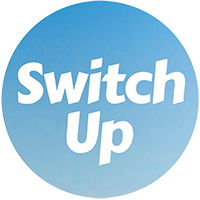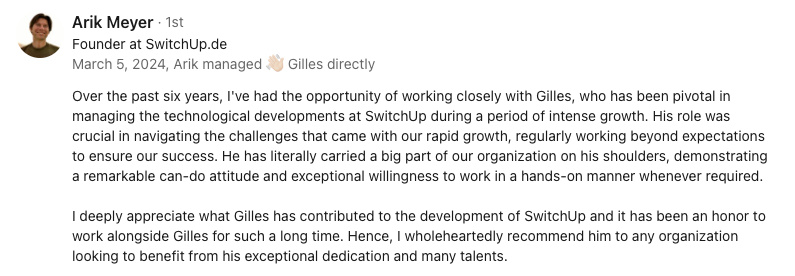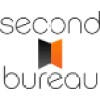silent advocates the secret to a lasting tech reputation
Abstract:
The article explores the influential yet often overlooked role of "silent advocates" in shaping tech careers—colleagues, clients, or managers who quietly speak well of you after you’ve moved on, often opening doors and protecting your reputation more effectively than formal references or self-promotion. It outlines how freelancers and independents, in particular, can benefit from these informal allies, and shares practical, minimalist strategies to encourage such advocacy: small gestures like thank-you notes, clear handover documents, or tidy resource lists can leave lasting positive impressions, known as "reputation artifacts." The piece highlights subtle ways to reduce reputation risk after leaving a role, such as clarifying unfinished work and providing helpful context, and explains how even low-effort actions—like brief, sincere farewells or making yourself available for future references—can sustain long-term goodwill. Drawing from the personal experience of moving to Lisbon for a simpler life, the author suggests that letting your work and reputation grow naturally through genuine, understated actions not only preserves professional standing but also supports a healthier work-life balance. Ultimately, the article argues that these quiet forms of advocacy, built on kindness and reliability rather than relentless networking, can be a powerful and sustainable way to future-proof your career in tech.
There’s a quiet force shaping careers in tech that doesn’t show up on LinkedIn or in official references. When leaving a tech company—whether you’re wrapping up a contract, moving on from a startup, or finishing a freelance project—the way you handle your exit can have a lasting impact on your reputation. Sometimes, long after you’ve moved on, your name still gets around—shared in group chats, mentioned in passing over coffee, or recommended during hiring talks. These silent supporters can sometimes have more influence on your path than a polished resume.
If you’re reading this with one month left in your notice period, here’s a tactical roadmap for making your exit count:
- Understand how informal, behind-the-scenes allies can open doors and protect your reputation.
- Use simple, minimalist gestures to spark lasting goodwill.
- Leave behind reputation artifacts that keep working for you.
- Protect your image and minimize risk, even after you’ve left.
- Spot the ripple effects of silent advocacy and let your reputation grow with minimal effort.
I’ll share practical tips, personal stories, and a few lessons learned from exits in Berlin, Beijing, and Shanghai—because I’ve seen firsthand how small actions can make a big difference, often when you least expect it.
The hidden power of silent advocates in tech
Who are silent advocates and why they matter—especially when you leave
When you leave a company or finish a freelance project, it’s tempting to think your references and LinkedIn recommendations are what really count. But in tech, something quieter is at play—especially during the exit process. Silent advocates are those colleagues, managers, or partners who mention your name positively after you’ve left—without you asking. Unlike formal references, this is spontaneous and feels real, sometimes meaning more than an official letter or endorsement. Knowing who these supporters are is just the start; their influence is especially strong in tech’s close circles, and it’s during transitions that their impact is most visible.
In my time leading a team in Beijing, I noticed that most new client leads came from informal referrals, not formal references. A quick recommendation from a silent supporter could make a hiring decision or bring in a new client, sometimes more than any document. For freelancers and independents, this matters even more—your reputation is your currency, and informal advocacy can open or close doors. For example:
- A project manager brings up your name in a Slack channel.
- A past client says good things about you to a potential client.
- An ex-team member mentions your reliability in a community forum.
If you work on your own, silent advocates are almost like secret agents for your career. Their behind-the-scenes support can lead to new gigs, introductions, or referrals you weren’t expecting. Small effort from you, but sometimes big results.
How silent advocacy works in practice
At times, silent advocates are the reason you get a surprising interview request or a project offer you didn’t expect. Maybe someone talked up your skills in a meeting, or a past manager cleared up a misunderstanding about your work after you’d left. These moments aren’t always visible, but they can shape your chances and help your reputation, sometimes before you know something is up.
Companies and networks often see silent advocacy through things like:
- Referral spikes traced back to an old team.
- Positive mentions of your work in alumni newsletters.
- Unprompted good notes landing in HR’s inbox.
When I was CTO in Berlin, I saw that after implementing a simple handover checklist, project delays dropped by 20%—a small act that led to more positive mentions and referrals from former colleagues. These are real signs someone is rooting for you.
Beyond numbers, silent advocates give something formal references don’t: real trust. Their support can boost your wins, counter unfair bias, and help your reputation in small but strong ways. This kind of advocacy can protect and improve your image well after you’ve moved on. So how can you get more of this quiet support? It starts with how you work together, communicate, and leave things behind—a subject for next.
Minimalist acts that build lasting goodwill
Small gestures that leave a mark
Helping out, even in small ways, is a smart move for winning invisible supporters. When I left my role in Berlin, I made sure to send a personal thank you to each team member—something that later led to unexpected referrals. Here are a few minimalist actions that have worked for me and others:
- Send a short, specific thank you to someone who helped you.
- Create a tidy set of links or tools for the team.
- Publicly acknowledge someone’s help in your farewell note.
- Share a short list of useful resources or contacts for the next person.
These gestures are easy to do, but they often stick in a teammate’s mind and can make them mention you later. I’ve found that even a quick Slack message or a handwritten note can become memorable and spark future advocacy.
Smoothing the transition with minimalist actions
A few simple gestures really stand out after someone leaves:
- Fix a lingering bug before you go.
- Leave clear instructions or a checklist for the next person.
- Share a short document with key contacts or project links.
Acts like these show you care about the team’s success, not just your own exit. People remember thoughtful exits and are more likely to say good things about you later. During my time building a cross-border e-commerce platform in Shanghai, a single thank-you note to a partner led to a crucial introduction months later—proof that small actions can have big payoffs.
Personal farewells and reputation echoes
Personal farewells, offers to stay in touch, and public thanks carry extra weight. Leaving a close-knit team in Berlin was tough—I worried my contributions would be forgotten. But a simple farewell message sparked ongoing connections I hadn’t expected. Try:
- Sending a quick thank you to each person.
- Sharing your contact info.
- Highlighting a team win in your goodbye note.
These become reputation markers that keep working for you later, building ongoing goodwill.
Leaving reputation footprints that last
What are reputation artifacts and why they matter
Reputation artifacts are things you leave behind that remind others of your work, like credits in docs, shout-outs in handover notes, or mentions in newsletters. These markers act as reminders of what you contributed, and future teammates or contacts can see them. For example, being named in a project doc or thanked in a newsletter can quietly affect how people talk about you long after you’ve left. These artifacts aren’t just nice—they can lead to real opportunities.
After implementing a simple handover checklist in Berlin, project delays dropped by 20%—a small act with a big impact. That checklist became a reference point for new hires and kept my name in the loop long after I’d moved on.
Simple ways to make your work visible
There’s no need to overdo it. Simple steps often work best:
- Add your name to the credits on a project or tool.
- Write a short “what I learned” or “key contacts” note in your handover.
- Make sure you’re mentioned in an alumni newsletter or on an alumni page.
These visible reminders make it easier for new colleagues or employers to see what you did, sometimes opening new opportunities or keeping your image strong.
Minimal effort, maximum effect
Even just a note highlighting team successes, a small line of credit, or a brief bit about lessons learned can help your reputation. During my time building an e-commerce platform in Shanghai, a single thank-you note to a partner led to a crucial introduction months later. One might leave a summary of open tasks or a thank you in a shared doc. These simple acts keep your name around in a positive light—very useful if things get messy after you go.
Minimizing reputation risk after you leave
Clarifying gaps and misperceptions
Leaving a job or project can feel awkward if things are left unsaid. As someone who has bootstrapped ventures and relied on referrals for new projects, I know how much a single positive mention can mean for your next paycheck. To avoid confusion or blame, consider:
- Clearly listing what’s done, what’s in progress, and what still needs attention as you leave.
- Writing a simple transition memo or checklist (it doesn’t have to be long).
- Giving a bit of honest context if a change or quick exit might raise questions—a short note explaining a project shift or team reorg helps stop rumors and sets the record straight.
Also, consider having a short chat with key people to answer questions and correct any early gossip. This way, you leave the story as you want it, not as others might tell it. While you can’t predict every surprise, a bit of preparation and openness shields your reputation well.
Preparing for post-exit surprises
It’s normal to feel anxious about what happens after you leave. I’ve found that a little preparation goes a long way in easing those worries. Even if you plan carefully, things may pop up after you leave—a bug, a tricky client question, or a lost detail. Try:
- Leaving an in case of emergency note or a short contact list with a trusted colleague.
- Keeping these notes safe (password-protected if needed) and only sharing with those who need them.
- Using clear, basic names for files and updating emergency notes as needed.
People often remember and appreciate this quiet planning. It shows you care and are reliable, and it can boost your reputation even after you’re gone.
One-time actions that plant seeds for future advocacy
Minimalist thank-you and goodbye messages
A thank-you or goodbye doesn’t have to be fancy. At heart, it’s about showing real gratitude, sharing a positive memory, and leaving space for future contact. These parts are simple but can help people remember you well. For example:
- Include a specific thank you.
- Add a positive note about your time together.
- Invite people to keep in touch.
Even quick messages like this can make a difference in future opportunities. For strict workplaces, a goodbye might sound like:
“Thank you for the opportunities for growth during my time here. I enjoyed working with you all, and I hope we can stay in touch. Please feel free to reach out anytime.”
For something more relaxed:
“It’s been great working together—thanks a lot! Let’s keep in touch on LinkedIn.”
Having a few quick templates ready makes saying goodbye easy. A short, honest message is easy for you to send but can be memorable for others. These gestures often stick after you leave a team or role.
You can also let people know you’re open to references without being obvious. A well-timed, simple note can encourage others to speak up for you in the future, keeping your name in the loop for opportunities.
Signaling openness to future references
Letting people know you’re open to future work or references doesn’t need to be pushy. A phrase like, “Hope we can keep in touch for future opportunities,” or, “Get in touch anytime if I can help,” quietly leaves the door open. These gentle signals are often enough to invite advocacy or even recommendations.
Offering to endorse others first is another easy way to build support. You might send, “Happy to write a recommendation for you if it’s useful—let me know.” This helps professional connections and can lead to future support, especially on platforms such as LinkedIn.
These small gestures fit well with a minimalist style—little effort but a good chance at lasting connections. For example, a quick endorsement or offer to keep in contact can slowly build a network of supporters.
How do you know silent advocacy is working? A bare-minimum approach can still support your reputation and leave you free to focus elsewhere.
Spotting the ripple effect of silent advocacy
Subtle signals your reputation is working for you
Sometimes you first notice silent advocacy is working when you’re caught off guard. Maybe a new client uses your name unexpectedly, or you get a referral for a job you never applied for. Positive feedback that reaches you through a friend, or a sudden wave of interest from your old team, are signs that someone’s speaking up for you. Even a nice comment in a group chat or a LinkedIn message from someone you barely know often points to your reputation spreading quietly.
Online activity or alumni engagement are also hints. Maybe you see your name in old company newsletters, or a past client comes back with more work. Social mentions, even if short, mean someone’s keeping your name in play.
Some real-world signs:
- Collaboration invites from former teammates.
- Positive mentions in alumni or industry communities.
- Repeat clients who heard about you from someone else.
You might notice these effects months or years later. Often, those who focus on steady, quality work and good relationships—not self-promotion—see them more. This fits a minimalist or indie mindset: do good work, treat people well, and let your reputation grow.
Why silent advocacy matches a minimalist indie approach
Letting reputation grow quietly
Letting your reputation grow passively—doing a few thoughtful things well, then stepping back—helps keep some balance between work and life. Minimalist strategies like this support both your professional growth and your personal well-being. After years of late nights in Beijing, I learned that a minimalist approach to reputation not only protects your career but also your peace of mind. Letting your work and small gestures speak for themselves is a good way to avoid the pressure of non-stop networking. After moving from big cities to Lisbon for a slower life, I’ve come to prefer these simple, low-maintenance ways of keeping in touch and earning respect, without much effort.
A sustainable reputation builds from quality work and honesty, not endless self-promotion. Quiet advocates aren’t just nice to have—they’re a practical tool to protect your image into the future.
Building a group of silent supporters is a low-effort way to keep your reputation strong for the long run. When time and energy are limited, having a few trusted allies is one of the most practical ways to remain relevant and respected, even after you move on.
Silent advocates may be the unsung heroes of a good tech career. Thoughtful acts, clear notes, and a simple thank-you can build a reputation that lasts long after you leave. Instead of chasing constant self-promotion, minimalist actions—like leaving helpful info or showing real appreciation—make it easy for others to remember and recommend you. This relaxed approach helps protect your image, and lets you keep better work-life balance and peace of mind. Sometimes, the smallest gestures or a bit of kindness ripple out, opening new doors and creating opportunities. The quiet paths we build might just turn out to be the strongest.














